Yitaek Kim
Robust Adaptive Time-Varying Control Barrier Function with Application to Robotic Surface Treatment
Jun 17, 2025Abstract:Set invariance techniques such as control barrier functions (CBFs) can be used to enforce time-varying constraints such as keeping a safe distance from dynamic objects. However, existing methods for enforcing time-varying constraints often overlook model uncertainties. To address this issue, this paper proposes a CBFs-based robust adaptive controller design endowing time-varying constraints while considering parametric uncertainty and additive disturbances. To this end, we first leverage Robust adaptive Control Barrier Functions (RaCBFs) to handle model uncertainty, along with the concept of Input-to-State Safety (ISSf) to ensure robustness towards input disturbances. Furthermore, to alleviate the inherent conservatism in robustness, we also incorporate a set membership identification scheme. We demonstrate the proposed method on robotic surface treatment that requires time-varying force bounds to ensure uniform quality, in numerical simulation and real robotic setup, showing that the quality is formally guaranteed within an acceptable range.
Towards Data-Driven Model-Free Safety-Critical Control
Jun 07, 2025Abstract:This paper presents a framework for enabling safe velocity control of general robotic systems using data-driven model-free Control Barrier Functions (CBFs). Model-free CBFs rely on an exponentially stable velocity controller and a design parameter (e.g. alpha in CBFs); this design parameter depends on the exponential decay rate of the controller. However, in practice, the decay rate is often unavailable, making it non-trivial to use model-free CBFs, as it requires manual tuning for alpha. To address this, a Neural Network is used to learn the Lyapunov function from data, and the maximum decay rate of the systems built-in velocity controller is subsequently estimated. Furthermore, to integrate the estimated decay rate with model-free CBFs, we derive a probabilistic safety condition that incorporates a confidence bound on the violation rate of the exponential stability condition, using Chernoff bound. This enhances robustness against uncertainties in stability violations. The proposed framework has been tested on a UR5e robot in multiple experimental settings, and its effectiveness in ensuring safe velocity control with model-free CBFs has been demonstrated.
Imitation Learning-Based Path Generation for the Complex Assembly of Deformable Objects
May 30, 2025Abstract:This paper investigates how learning can be used to ease the design of high-quality paths for the assembly of deformable objects. Object dynamics plays an important role when manipulating deformable objects; thus, detailed models are often used when conducting motion planning for deformable objects. We propose to use human demonstrations and learning to enable motion planning of deformable objects with only simple dynamical models of the objects. In particular, we use the offline collision-free path planning, to generate a large number of reference paths based on a simple model of the deformable object. Subsequently, we execute the collision-free paths on a robot with a compliant control such that a human can slightly modify the path to complete the task successfully. Finally, based on the virtual path data sets and the human corrected ones, we use behavior cloning (BC) to create a dexterous policy that follows one reference path to finish a given task.
Safe Uncertainty-Aware Learning of Robotic Suturing
May 22, 2025Abstract:Robot-Assisted Minimally Invasive Surgery is currently fully manually controlled by a trained surgeon. Automating this has great potential for alleviating issues, e.g., physical strain, highly repetitive tasks, and shortages of trained surgeons. For these reasons, recent works have utilized Artificial Intelligence methods, which show promising adaptability. Despite these advances, there is skepticism of these methods because they lack explainability and robust safety guarantees. This paper presents a framework for a safe, uncertainty-aware learning method. We train an Ensemble Model of Diffusion Policies using expert demonstrations of needle insertion. Using an Ensemble model, we can quantify the policy's epistemic uncertainty, which is used to determine Out-Of-Distribution scenarios. This allows the system to release control back to the surgeon in the event of an unsafe scenario. Additionally, we implement a model-free Control Barrier Function to place formal safety guarantees on the predicted action. We experimentally evaluate our proposed framework using a state-of-the-art robotic suturing simulator. We evaluate multiple scenarios, such as dropping the needle, moving the camera, and moving the phantom. The learned policy is robust to these perturbations, showing corrective behaviors and generalization, and it is possible to detect Out-Of-Distribution scenarios. We further demonstrate that the Control Barrier Function successfully limits the action to remain within our specified safety set in the case of unsafe predictions.
Trajectory Optimization for In-Hand Manipulation with Tactile Force Control
Mar 11, 2025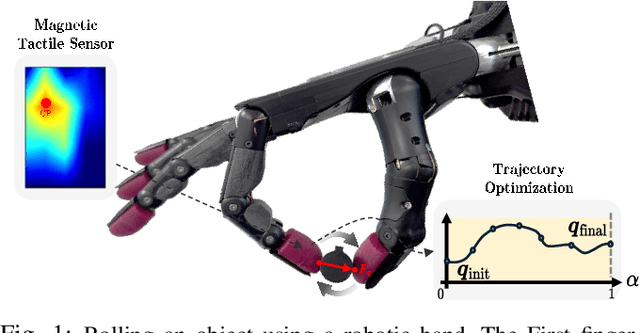
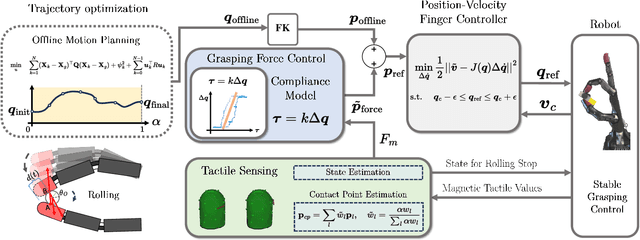
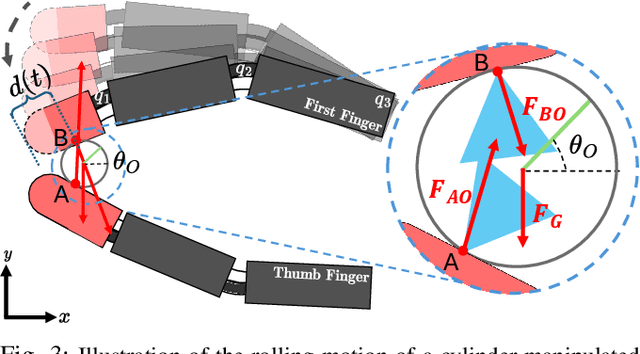
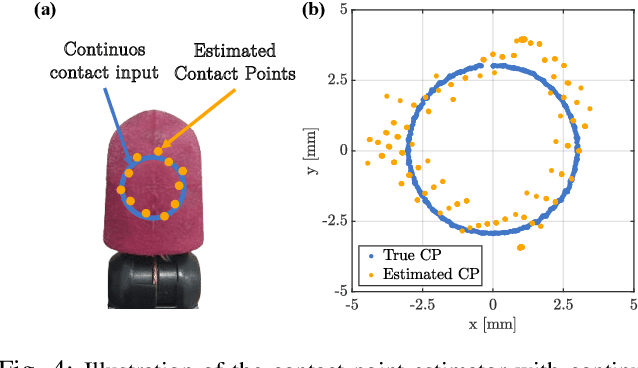
Abstract:The strength of the human hand lies in its ability to manipulate small objects precisely and robustly. In contrast, simple robotic grippers have low dexterity and fail to handle small objects effectively. This is why many automation tasks remain unsolved by robots. This paper presents an optimization-based framework for in-hand manipulation with a robotic hand equipped with compact Magnetic Tactile Sensors (MTSs). The small form factor of the robotic hand from Shadow Robot introduces challenges in estimating the state of the object while satisfying contact constraints. To address this, we formulate a trajectory optimization problem using Nonlinear Programming (NLP) for finger movements while ensuring contact points to change along the geometry of the fingers. Using the optimized trajectory from the solver, we implement and test an open-loop controller for rolling motion. To further enhance robustness and accuracy, we introduce a force controller for the fingers and a state estimator for the object utilizing MTSs. The proposed framework is validated through comparative experiments, showing that incorporating the force control with compliance consideration improves the accuracy and robustness of the rolling motion. Rolling an object with the force controller is 30\% more likely to succeed than running an open-loop controller. The demonstration video is available at https://youtu.be/6J_muL_AyE8.
Safety-Ensured Control Framework for Robotic Endoscopic Task Automation
Mar 11, 2025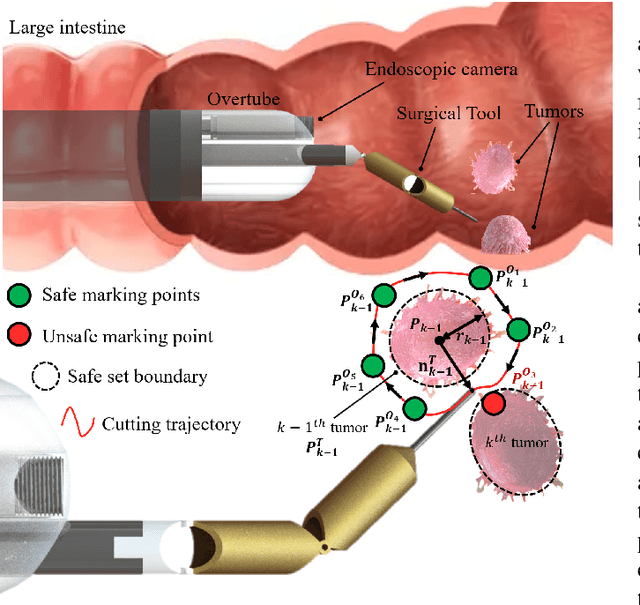
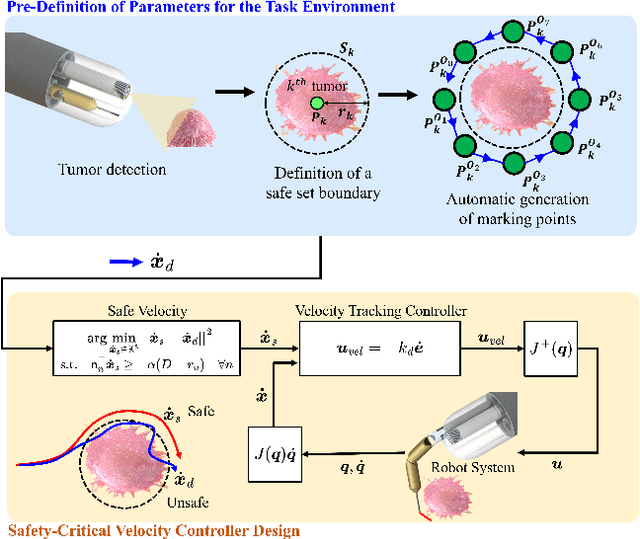
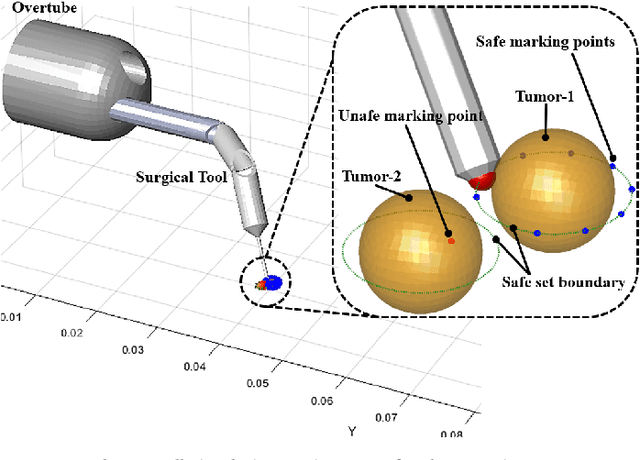
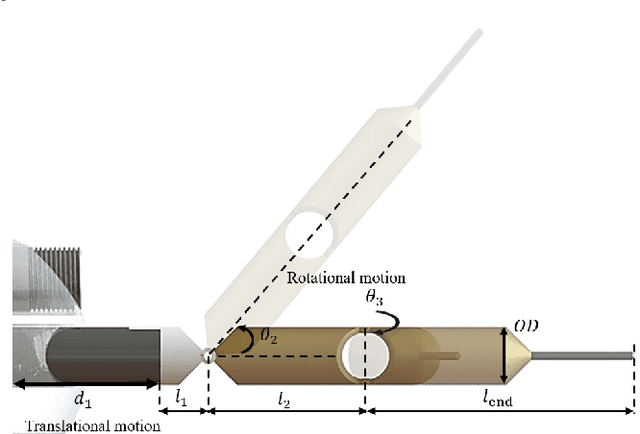
Abstract:There is growing interest in automating surgical tasks using robotic systems, such as endoscopy for treating gastrointestinal (GI) cancer. However, previous studies have primarily focused on detecting and analyzing objects or robots, with limited attention to ensuring safety, which is critical for clinical applications, where accidents can be caused by unsafe robot motions. In this study, we propose a new control framework that can formally ensure the safety of automating certain processes involved in endoscopic submucosal dissection (ESD), a representative endoscopic surgical method for the treatment of early GI cancer, by using an endoscopic robot. The proposed framework utilizes Control Barrier Functions (CBFs) to accurately identify the boundaries of individual tumors, even in close proximity within the GI tract, ensuring precise treatment and removal while preserving the surrounding normal tissue. Additionally, by adopting a model-free control scheme, safety assurance is made possible even in endoscopic robotic systems where dynamic modeling is challenging. We demonstrate the proposed framework in cases where the tumors to be removed are close to each other, showing that the safety constraints are enforced. We show that the model-free CBF-based controlled robot eliminates one tumor completely without damaging it, while not invading another nearby tumor.
Robust Adaptive Safe Robotic Grasping with Tactile Sensing
Nov 12, 2024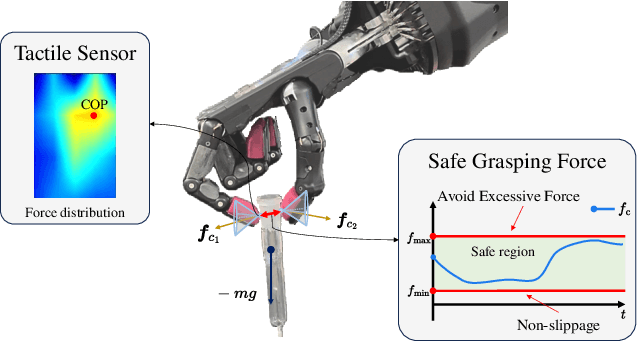


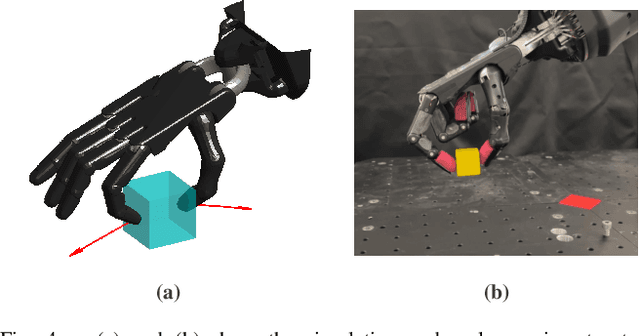
Abstract:Robotic grasping requires safe force interaction to prevent a grasped object from being damaged or slipping out of the hand. In this vein, this paper proposes an integrated framework for grasping with formal safety guarantees based on Control Barrier Functions. We first design contact force and force closure constraints, which are enforced by a safety filter to accomplish safe grasping with finger force control. For sensory feedback, we develop a technique to estimate contact point, force, and torque from tactile sensors at each finger. We verify the framework with various safety filters in a numerical simulation under a two-finger grasping scenario. We then experimentally validate the framework by grasping multiple objects, including fragile lab glassware, in a real robotic setup, showing that safe grasping can be successfully achieved in the real world. We evaluate the performance of each safety filter in the context of safety violation and conservatism, and find that disturbance observer-based control barrier functions provide superior performance for safety guarantees with minimum conservatism. The demonstration video is available at https://youtu.be/Cuj47mkXRdg.
Fixture calibration with guaranteed bounds from a few correspondence-free surface points
Mar 04, 2024Abstract:Calibration of fixtures in robotic work cells is essential but also time consuming and error-prone, and poor calibration can easily lead to wasted debugging time in downstream tasks. Contact-based calibration methods let the user measure points on the fixture's surface with a tool tip attached to the robot's end effector. Most such methods require the user to manually annotate correspondences on the CAD model, however, this is error-prone and a cumbersome user experience. We propose a correspondence-free alternative: The user simply measures a few points from the fixture's surface, and our method provides a tight superset of the poses which could explain the measured points. This naturally detects ambiguities related to symmetry and uninformative points and conveys this uncertainty to the user. Perhaps more importantly, it provides guaranteed bounds on the pose. The computation of such bounds is made tractable by the use of a hierarchical grid on SE(3). Our method is evaluated both in simulation and on a real collaborative robot, showing great potential for easier and less error-prone fixture calibration. Project page at https://sites.google.com/view/ttpose
 Add to Chrome
Add to Chrome Add to Firefox
Add to Firefox Add to Edge
Add to Edge